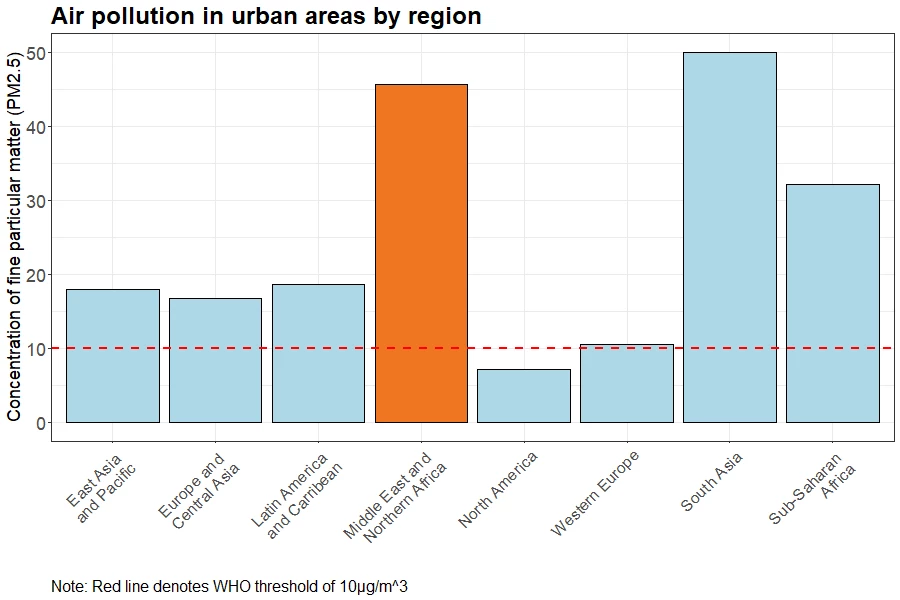 دخان منبعث من مصنع مجاور للمدينة.
دخان منبعث من مصنع مجاور للمدينة.
What is the best path to building better and greener after the pandemic? Leaders around the globe ask this question and come up with different answers. For example, the European Union puts the spotlight on nature as the strongest ally in green recovery after COVID-19. South Korea plans to invest in green cities and support new green industries and businesses, among others. The best recipe for success differs across countries and regions, but as made clear in this previous op-ed, the Middle East and North Africa (MENA) region will need to include green and sustainable practices for a more resilient and inclusive recovery.
As World Bank President David Malpass has said, “A lot of the natural systems have been neglected over the years: the pollution in water, the pollution in the air, the climate events that are more and more frequent; the water quality and marine plastics are also challenges.” The current COVID-19 pandemic has highlighted the need to focus on those issues for a better recovery after the crisis.
Currently, there are two opportunities that are especially relevant for MENA:
- Improving urban air quality. The MENA region has the highest air pollution levels after South Asia (see figure below). Most of the populations in MENA’s cities live with air pollution that surpasses the World Health Organization (WHO) thresholds for what is considered healthy air by 4-5 times.
Source: World Bank (2020) based on data from WHO (2020).
According to our forthcoming report, the high ambient air pollution concentration in the region is the cause of detrimental health effects, leading to more than 250,000 premature deaths and millions of people suffering from respiratory and cardiovascular diseases, among many others. Ambient air pollution is the 4th most important risk factor for premature death, following metabolic and dietary risks and tobacco consumption. It is noteworthy that ambient air pollution is the main risk factor that is outside of the control of an individual and which requires collective action. Ambient air pollution causes as many deaths as road injuries, diabetes, tuberculosis, malaria, HIV/AIDS and acute hepatitis combined. The linkages between COVID-19 and air pollution has been brought to public debate during this pandemic crisis.
The economic costs of the health effects from air pollution are staggering as people’s labor productivity is reduced. In Greater Cairo, where environmental health issues weigh heavily on residents’ quality of life and the economy, the cost amount to the equivalent of about 1.4% of national Gross Domestic Product (GDP). The World Bank recently approved a US$200 million project to support Egypt’s initiatives to reduce air and climate pollution from critical sectors and to increase resilience to air pollution in Greater Cairo. The project focusses on the two main sources of ambient air pollution, namely transport and solid-waste burning.
- Improving integrated coastal zone management: In MENA, most of the population resides and concentrates its economic activities within 100 km of the coast, including industries, ports, and tourism assets. There are growing concerns about these area’s environmental sustainability as the population is projected to double by 2050, and rapid urbanization will put more pressure on coastal zones. Today, 80% of the Mediterranean Sea’s pollution loads comes from land-based sources, especially poorly managed plastic waste. In particular, the Mashreq and Maghreb regions have high rates of mismanaged plastic waste and more than half of it is not adequately managed, seeping into the sea (figure below will be in our forthcoming report). This is being aggravated also by the impact of the COVID-19 pandemic.

Source: World Bank (2020) based on Jambeck et al (2015).
MENA’s coasts are also vulnerable to erosion. Receding coastlines and disappearing beaches are linked to Sea-Level Rise. Although the global average coastline recession is about 0.07 meters per year (m/yr), Tunisia is the most affected. As our upcoming report shows, the country has rates 10 times higher, amounting to more than 0.70 m/yr. Another example is Morocco, where the Atlantic coast is currently receding at a rate of 0.12 m/yr and its Mediterranean coast at 0.14 m/yr. The coasts are vital for tourism; this is why the country must take advantage of the opportunity now to manage coastal erosion to sustain a recovery of the sector after the pandemic.
As MENA cities grow, especially on the coasts, recovery from the COVID-19 crisis calls for a greener, more resilient, and more inclusive development path to provide for healthy citizens in less-polluted cities. Cleaner coasts and oceans can secure millions of “blue economy” jobs through a more efficient and resilient management of natural resources. This resilient economic recovery will be more inclusive if the plan incorporates nature-based solutions in favor of the environment, the region's natural capital, and the efficient use of resources.
The two opportunities mentioned above can only be taken advantage of with reforms in policies, institutions, and governance, improved data availability and transparency, and citizen participation. MENA countries have the opportunity to move towards a green, resilient, and inclusive future with better quality of air and well-managed coasts. Governments and their citizens have the best chance now to take up the challenge and move forward.





Join the Conversation